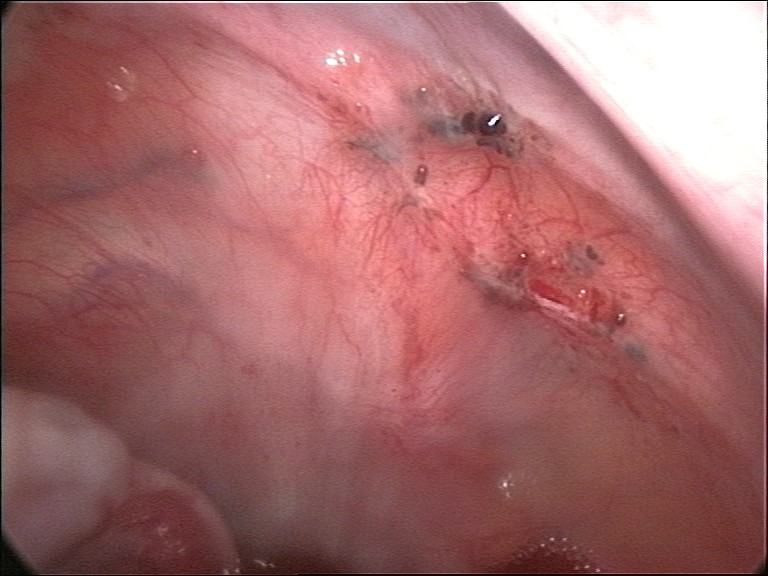|
Imperforate Hymen
An imperforate hymen is a congenital disorder where a hymen without an opening completely obstructs the vagina. It is caused by a failure of the hymen to perforate during fetal development. It is most often diagnosed in adolescent girls when menstrual blood accumulates in the vagina and sometimes also in the uterus. It is treated by surgical incision of the hymen. Signs and symptoms Affected newborns may present with acute urinary retention. In adolescent females, the most common symptoms of an imperforate hymen are cyclic pelvic pain and amenorrhea; other symptoms associated with hematocolpos include urinary retention, constipation, low back pain, nausea, and diarrhea. Other vaginal anomalies can have similar symptoms to an imperforate hymen. Vaginal atresia and a transverse vaginal septum require differentiation. A strong urge to defecate has been observed in a few women. Complications If untreated or unrecognized before puberty, an imperforate hymen can lead to peritonitis ... [...More Info...] [...Related Items...] OR: [Wikipedia] [Google] [Baidu] |
Gynecology
Gynaecology or gynecology (see American and British English spelling differences) is the area of medicine concerned with conditions affecting the Female reproductive system, female reproductive system. It is often paired with the field of obstetrics, which focuses on pregnancy and childbirth, thereby forming the combined area of obstetrics and gynaecology (OB-GYN). Gynaecology encompasses both Primary care, primary and Preventive healthcare, preventative care of issues related to female reproduction and sexual health, such as the uterus, vagina, fallopian tubes, ovaries, and breasts; subspecialties include family planning; minimally invasive surgery; pediatric and adolescent gynecology; and pelvic medicine and reconstructive surgery. While gynaecology has traditionally centered on Cisgender, cisgender women, it increasingly encompasses anyone with female organs, including transgender, intersex, and Non-binary gender, nonbinary individuals; however, many non-cis women face acce ... [...More Info...] [...Related Items...] OR: [Wikipedia] [Google] [Baidu] |
Vaginal Anomalies
Vaginal anomalies are abnormal structures that are formed (or not formed) during the prenatal development of the female reproductive system and are rare congenital defects that result in an abnormal or absent vagina. When present, they are often found with uterine, skeletal and urinary abnormalities. This is because these structures, like the vagina, are most susceptible to disruption during crucial times of organ-genesis. Many of these defects are classified under the broader term Müllerian duct anomalies. Müllerian duct anomalies are caused by a disturbance during the embryonic time of genitourinary development. The other isolated incidents of vaginal anomalies can occur with no apparent cause. Oftentimes vaginal anomalies are part of a cluster of defects or syndromes. In addition, inheritance can play a part as can prenatal exposure to some teratogens.The inheritance patterns of some vaginal anomalies can be autosomal dominant, autosomal recessive, and X-linked disorders. ... [...More Info...] [...Related Items...] OR: [Wikipedia] [Google] [Baidu] |
Labia Majora
In primates, and specifically in humans, the labia majora (: labium majus), also known as the outer lips or outer labia, are two prominent Anatomical terms of location, longitudinal skin folds that extend downward and backward from the mons pubis to the perineum. Together with the labia minora, they form the labia of the vulva. The labia majora are Homology (biology), homologous to the male scrotum. Etymology ''Labia majora'' is the Latin plural for big ("major") lips. The Latin term ''labium/labia'' is used in anatomy for a number of usually paired parallel structures, but in English, it is mostly applied to two pairs of parts of the vulva—labia majora and labia minora. Traditionally, to avoid confusion with other lip-like structures of the body, the vulvar labia were termed by anatomists in Latin as ''labia majora (''or ''minora) pudendi.'' Embryology Embryologically, they develop from labioscrotal folds. The labia majora after puberty may become of a darker color than the ... [...More Info...] [...Related Items...] OR: [Wikipedia] [Google] [Baidu] |
Posterior Labial Commissure
In primates, and specifically in humans, the labia majora (: labium majus), also known as the outer lips or outer labia, are two prominent longitudinal skin folds that extend downward and backward from the mons pubis to the perineum. Together with the labia minora, they form the labia of the vulva. The labia majora are homologous to the male scrotum. Etymology ''Labia majora'' is the Latin plural for big ("major") lips. The Latin term ''labium/labia'' is used in anatomy for a number of usually paired parallel structures, but in English, it is mostly applied to two pairs of parts of the vulva—labia majora and labia minora. Traditionally, to avoid confusion with other lip-like structures of the body, the vulvar labia were termed by anatomists in Latin as ''labia majora (''or ''minora) pudendi.'' Embryology Embryologically, they develop from labioscrotal folds. The labia majora after puberty may become of a darker color than the skin outside them and grow pubic hair on their ex ... [...More Info...] [...Related Items...] OR: [Wikipedia] [Google] [Baidu] |
Ultrasound
Ultrasound is sound with frequency, frequencies greater than 20 Hertz, kilohertz. This frequency is the approximate upper audible hearing range, limit of human hearing in healthy young adults. The physical principles of acoustic waves apply to any frequency range, including ultrasound. Ultrasonic devices operate with frequencies from 20 kHz up to several gigahertz. Ultrasound is used in many different fields. Ultrasonic devices are used to detect objects and measure distances. Ultrasound imaging or sonography is often used in medicine. In the nondestructive testing of products and structures, ultrasound is used to detect invisible flaws. Industrially, ultrasound is used for cleaning, mixing, and accelerating chemical processes. Animals such as bats and porpoises use ultrasound for locating prey and obstacles. History Acoustics, the science of sound, starts as far back as Pythagoras in the 6th century BC, who wrote on the mathematical properties of String instrument ... [...More Info...] [...Related Items...] OR: [Wikipedia] [Google] [Baidu] |
Menarche
Menarche ( ; ) is the first menstrual cycle, or first menstruation, menstrual bleeding, in female humans. From both social and medical perspectives, it is often considered the central event of female puberty, as it signals the possibility of fertility. Girls experience menarche at different ages, but the most common age is 12. Having menarche occur between the ages of 9–14 in the West is considered normal.US National Health Statistics Report September 2020 The timing of menarche is influenced by female biology, as well as Genetics, genetic, environmental factors, and nutritional factors. The mean age of menarche has declined over the last century, but the magnitude of the decline and the factors responsible remain subjects of contention. The worldwide average age of menarche is very difficult to estimate ... [...More Info...] [...Related Items...] OR: [Wikipedia] [Google] [Baidu] |
EMedicine
eMedicine is an online clinical medical knowledge base founded in 1996 by doctors Scott Plantz and Jonathan Adler, and computer engineers Joanne Berezin and Jeffrey Berezin. The eMedicine website consists of approximately 6,800 medical topic review articles, each of which is associated with a clinical subspecialty "textbook". The knowledge base includes over 25,000 clinically multimedia files. Each article is authored by board certified specialists in the subspecialty to which the article belongs and undergoes three levels of physician peer-review, plus review by a Doctor of Pharmacy. The article's authors are identified with their current faculty appointments. Each article is updated yearly, or more frequently as changes in practice occur, and the date is published on the article. eMedicine.com was sold to WebMD in January, 2006 and is available as the Medscape Reference. History Plantz, Adler and Berezin evolved the concept for eMedicine.com in 1996 and deployed the initia ... [...More Info...] [...Related Items...] OR: [Wikipedia] [Google] [Baidu] |
Definitive Urogenital Sinus
The urogenital sinus is a body part of a human or other placental only present in the development of the urinary and reproductive organs. It is the ventral part of the cloaca, formed after the cloaca separates from the anal canal during the fourth to seventh weeks of development. In males, the UG sinus is divided into three regions: upper, pelvic, and phallic. The upper part gives rise to the urinary bladder and the pelvic part gives rise to the prostatic and membranous parts of the urethra, the prostate and the bulbourethral glands (Cowper's). The phallic portion gives rise to the spongy (bulbar) part of the urethra and the urethral glands (Littré's). In females, the pelvic part of the UG sinus gives rise to the sinovaginal bulbs, structures that will eventually form the inferior two thirds of the vagina. This process begins when the lower tip of the paramesonephric ducts, the structures that will eventually form the uterus and vaginal fornices, come in contact with ... [...More Info...] [...Related Items...] OR: [Wikipedia] [Google] [Baidu] |
Urinary Tract Infection
A urinary tract infection (UTI) is an infection that affects a part of the urinary tract. Lower urinary tract infections may involve the bladder (cystitis) or urethra (urethritis) while upper urinary tract infections affect the kidney (pyelonephritis). Symptoms from a lower urinary tract infection include suprapubic pain, painful urination (dysuria), frequency and urgency of urination despite having an empty bladder. Symptoms of a kidney infection, on the other hand, are more systemic and include fever or Abdominal pain, flank pain usually in addition to the symptoms of a lower UTI. Rarely, the urine may appear Hematuria, bloody. Symptoms may be vague or non-specific at the extremities of age (i.e. in patients who are very young or old). The most common cause of infection is ''Escherichia coli'', though other bacteria or fungi may sometimes be the cause. Risk factors include female anatomy, sexual intercourse, diabetes mellitus, diabetes, obesity, catheterisation, and famil ... [...More Info...] [...Related Items...] OR: [Wikipedia] [Google] [Baidu] |
Mucometrocolpos
Mucometrocolpos is the abnormal accumulation of genital secretions (mucus) that occur as a result of an imperforate hymen and the buildup of these secretions behind the hymen. The secretions originate from uterine and cervical glands. It is a rare, congenital condition and usually occurs independent of other abnormal structures though inheritance can play a part in its occurrence. It also occurs with McKusick–Kaufman syndrome (MKS). Polydactyly and heart disease are associated with this condition. Diagnosis is challenging because symptoms also occur in a variety of other syndromes. Secretions can build up and extend as far as the uterus and abdomen. Mucometrocolpos can sometimes cause abdominal distention. The build up of mucous secretions can occur prior to adolescence unrelated to menstruation Menstruation (also known as a period, among other colloquial terms) is the regular discharge of blood and Mucous membrane, mucosal tissue from the endometrium, inner lining of the ute ... [...More Info...] [...Related Items...] OR: [Wikipedia] [Google] [Baidu] |
Menstruation
Menstruation (also known as a period, among other colloquial terms) is the regular discharge of blood and Mucous membrane, mucosal tissue from the endometrium, inner lining of the uterus through the vagina. The menstrual cycle is characterized by the rise and fall of hormones. Menstruation is triggered by falling progesterone levels, and is a sign that pregnancy has not occurred. Women use feminine hygiene products to maintain hygiene during menses. The first period, a point in time known as menarche, usually begins during puberty, between the ages of 11 and 13. However, menstruation starting as young as 8 years would still be considered normal. The average age of the first period is generally later in the developing world, and earlier in the developed world. The typical length of time between the first day of one period and the first day of the next is 21 to 45 days in young women; in adults, the range is between 21 and 35 days with the average often cited as 28 days. In the b ... [...More Info...] [...Related Items...] OR: [Wikipedia] [Google] [Baidu] |
Endometriosis
Endometriosis is a disease in which Tissue (biology), tissue similar to the endometrium, the lining of the uterus, grows in other places in the body, outside the uterus. It occurs in women and a limited number of other female mammals. Endometrial tissue most often grows on or around reproductive organs such as the ovaries and fallopian tubes, on the outside surface of the uterus, or the tissues surrounding the uterus and the ovaries (peritoneum). It can also grow on other organs in the pelvic region like the Gastrointestinal tract, bowels, stomach, bladder, or the cervix. Rarely, it can also occur in other parts of the body. Symptoms can be very different from person to person, varying in range and intensity. About 25% of individuals have no symptoms, while for some it can be a debilitating disease. Common symptoms include pelvic pain, Heavy menstrual bleeding, heavy and Dysmenorrhea, painful periods, pain with bowel movements, Dysuria, painful urination, Dyspareunia, pain dur ... [...More Info...] [...Related Items...] OR: [Wikipedia] [Google] [Baidu] |







